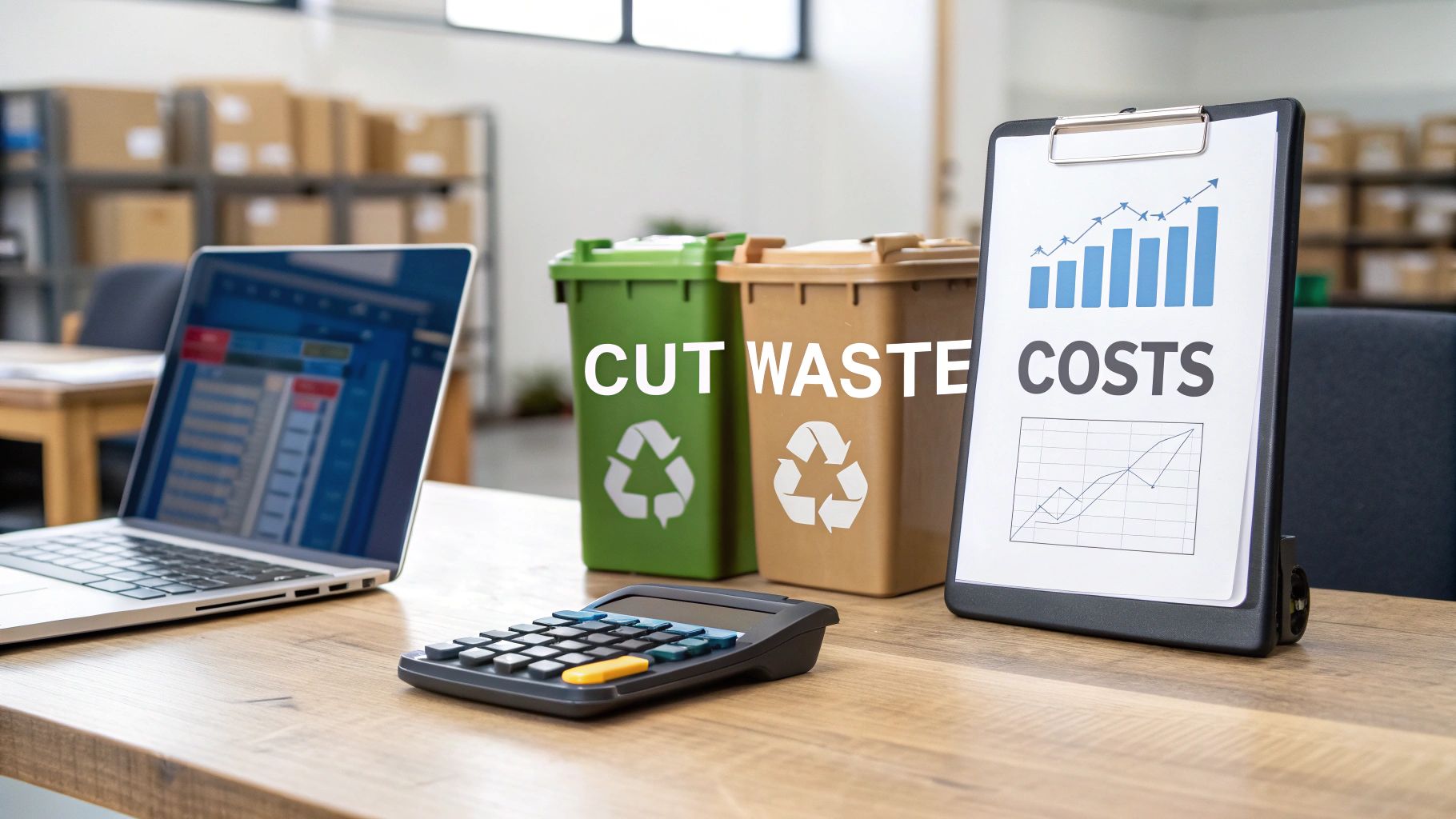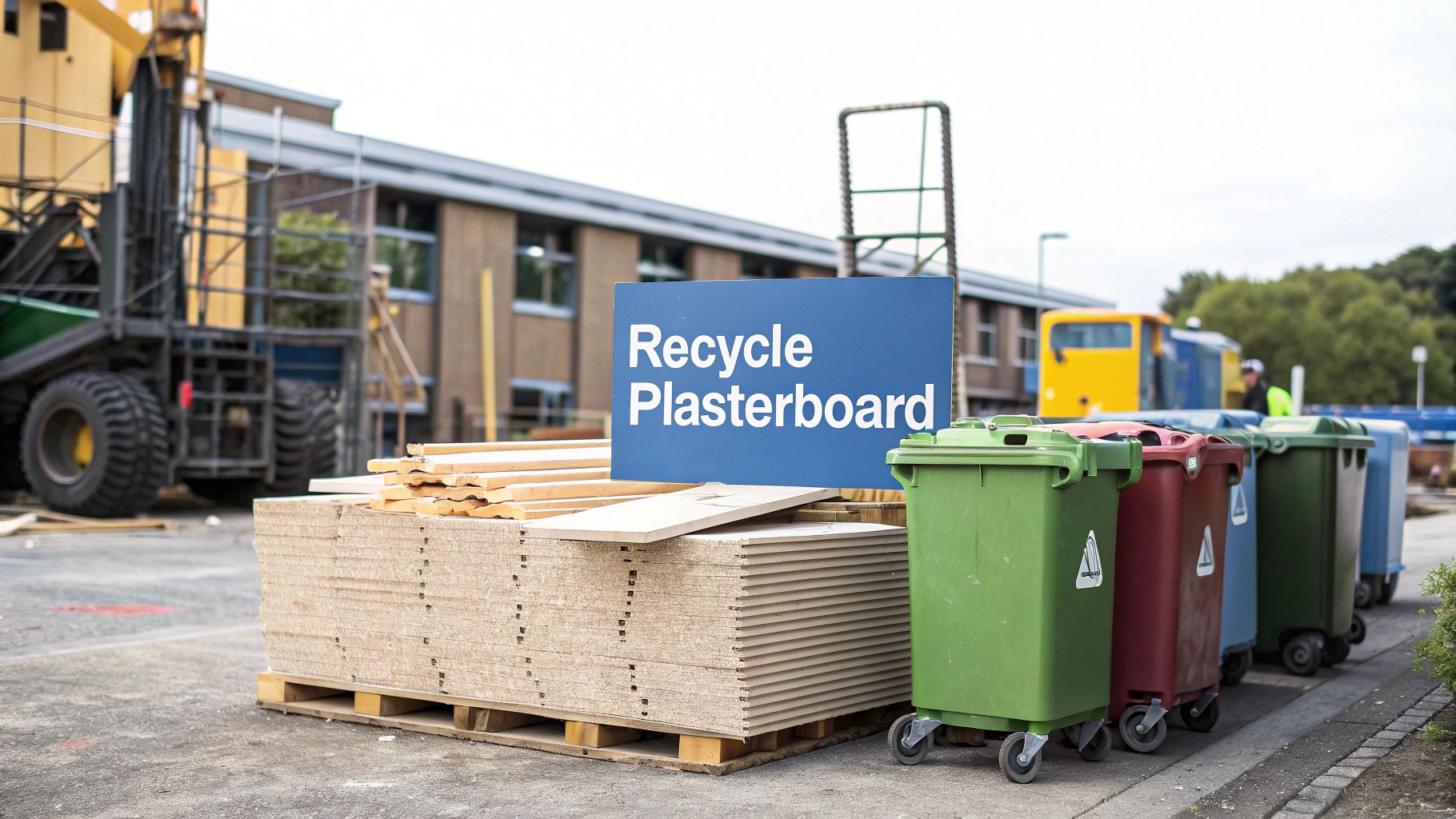How to Recycle Plaster in the UK a Practical Guide
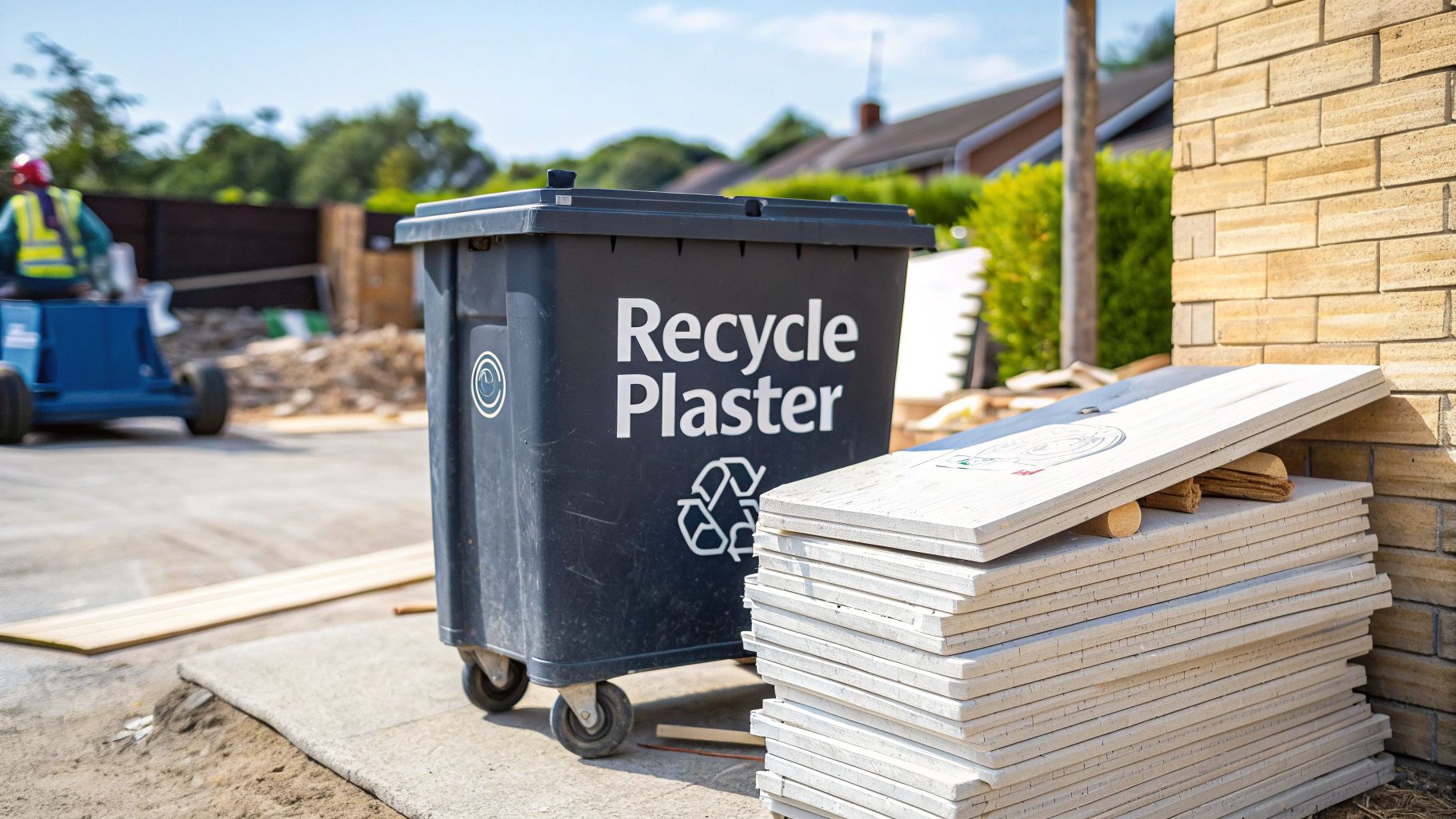
How to Recycle Plaster in the UK a Practical Guide
Recycling plaster isn't just a nice idea; it's an absolutely critical part of any responsible building or renovation job. It all comes down to separating your plasterboard waste from everything else on site. You've got to pull out all the contaminants—screws, tiles, bits of wood—before sending it off to a specialist facility.
Doing this means the valuable gypsum core can be recovered and turned back into new plasterboard. It's a simple step that stops a whole lot of environmental damage and saves precious resources.
Why You Can't Just Chuck Plaster in a Skip
Let's move past the general 'recycling is good' chat. To really get why plaster recycling is a must, you need to understand the serious environmental and financial headaches it causes when you get it wrong. For years, the go-to solution for construction waste was just to chuck it all in a landfill. But we now know that certain materials, especially plasterboard, are a ticking time bomb when handled this way.
The problem is the gypsum. It's the main ingredient in plaster, and when it gets buried in a landfill and mixes with other biodegradable rubbish, it starts to break down in a low-oxygen environment. This chemical reaction pumps out hydrogen sulphide (H₂S) – a toxic, rotten-egg-smelling gas. It’s not just a nasty smell; it’s a real health hazard for anyone working on or living near the site.
The Environmental and Financial Reality
Putting aside the immediate chemical dangers, the sheer volume of plasterboard being thrown away is staggering. The UK construction industry produces a mountain of the stuff. We’re talking over one million tonnes of plasterboard waste every single year, mostly from off-cuts on new builds and rubble from demolition jobs.
Most of that used to go straight to landfill, but thankfully, regulations are now putting a stop to that. Professionals like sustainable design architects have been pushing for this for years, building eco-friendly principles into projects right from the start. They see the bigger picture—creating a circular economy where we reuse materials instead of just binning them.
By keeping plaster out of landfills, we're not just stopping toxic gas from being released. We're also conserving virgin gypsum, which cuts down on the need for mining—an energy-guzzling process that leaves a massive environmental scar.
UK Rules and Landfill Taxes
The financial case for recycling plaster is just as strong as the environmental one. UK regulations have tightened up significantly, and they specifically target gypsum-based waste. It's now illegal to send plasterboard to a landfill if it's mixed in with other biodegradable waste.
To give this rule teeth, landfill tax rates have shot up, making mixed waste disposal incredibly expensive. If you send a contaminated skip to landfill, you could be hit with some eye-watering fees and potential fines.
In contrast, using a dedicated plasterboard recycling service is often the cheaper option because it sidesteps these taxes completely. The financial incentive is clear:
- You avoid hefty landfill taxes that apply to mixed waste.
- You stay on the right side of the law and comply with environmental regulations.
- You build a reputation as a sustainable business.
When you look at it that way, recycling plaster is no longer just a 'green' choice. It's a smart, legally required, and financially sound decision for everyone, from the weekend DIYer to the biggest construction firms.
Preparing Your Plaster for Successful Recycling
Getting your plaster waste ready for recycling is, without a doubt, the most important step in the whole process. Whether it gets a second life or ends up in a landfill really boils down to one word: segregation.
From the moment it's stripped from a wall, plasterboard has to be kept completely separate from every other bit of site waste. No exceptions.
If you mix plaster with general rubbish, you're pretty much guaranteeing it a one-way ticket to the tip, which will hit you in the wallet. Even a tiny amount of contamination—a few stray bits of wood, some insulation, or a stray metal fixing—can get an entire load rejected at the recycling plant. It’s not them being fussy; their machinery is designed for pure gypsum and simply can't handle the other stuff.
This infographic lays it out perfectly, showing the two very different journeys your plaster waste can take.
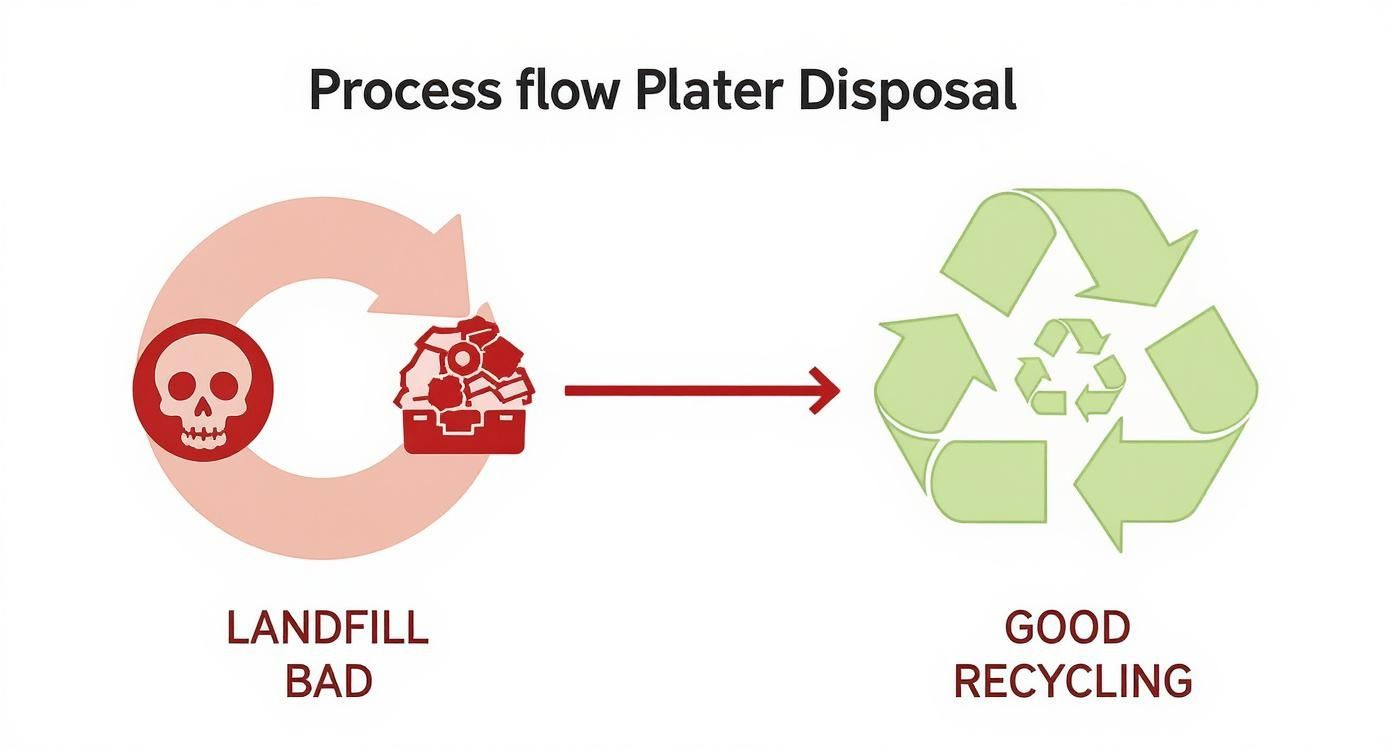
As you can see, one path leads to wasted resources and environmental damage. The other is a closed-loop system, turning old plasterboard back into a brand-new, valuable product.
Creating a Plaster-Only Waste Stream
The principle is the same whether you're a DIY enthusiast clearing out a single room or a contractor managing a massive renovation site. You absolutely need a dedicated container just for plasterboard.
- For small projects: A tonne bag (you might know it as a bulk bag or dumpy bag) is a brilliant, low-cost solution. Just fill it with your clean plasterboard waste as you work.
- For larger jobs: Hiring a dedicated plasterboard skip is the way to go. It gives everyone on site a clear, designated place to put gypsum waste, making it much easier to keep things separate.
If you're mapping out a big home improvement project, like working through a comprehensive bathroom renovation checklist, factoring in waste segregation from day one will save you a world of headaches and unexpected costs down the line.
Removing Contaminants Before Collection
Once you’ve got your dedicated bag or skip sorted, the real work begins: making sure only clean plaster goes into it. Before you throw any plasterboard away, you have to strip off anything that isn't the gypsum core or its paper liner.
Think of it like prepping vegetables for a stew—you need to get rid of all the inedible bits first. Common culprits that need to be removed include:
- Metal Fixings: Screws, nails, and any metal corner beads.
- Wooden Elements: Laths or timber framework still attached.
- Insulation: Any foam or mineral wool stuck to the back.
- Tiles and Adhesives: Old ceramic tiles and the thick beds of adhesive they're stuck on with.
- Plastic Fittings: Sockets, light switches, and wall plugs.
The ultimate aim is to send off a load that is 98-99% pure gypsum waste. While a bit of paint or wallpaper is usually fine, anything more substantial will clog up the recycling process and likely get your load rejected.
This need for meticulous separation is a major reason why the UK isn't recycling nearly as much plaster as it could. Our recycling plants have the combined capacity to process around 175,000 tonnes a year, but they're only actually receiving about 70,000 tonnes.
That huge gap exists simply because getting a steady stream of clean, segregated plaster is a real challenge. For some, mixing it all and sending it to landfill just seems easier, though it's a far less responsible choice. You can dig into the specifics of this challenge in the full UK WRAP report.
Finding Plaster Recycling Services in Your Area
You’ve done the hard work of carefully separating your plasterboard, making sure it’s clean and ready for its next life. Now for the final, crucial step: getting it to a specialist facility that knows exactly what to do with it.
Whether you're a DIY enthusiast with just a few offcuts or a contractor with a lorry-load, you've got some solid options. The right choice really comes down to the scale of your project, your budget, and how much of the logistics you want to handle yourself.
Dedicated Plasterboard Skip Hire
Got a medium to large-scale renovation or construction project on the go? Hiring a skip specifically for plasterboard is almost always the most sensible route. When you hire a dedicated plasterboard skip, the waste company handles everything—from transport to making sure it gets to a licensed recycling facility.
It just makes sense.
- Convenience: The skip arrives on-site and gets collected when it's full. No fuss, no hassle.
- Compliance: This is a big one. It guarantees your plaster waste is handled by the book, keeping you compliant with UK waste regulations.
- Cost-Effective: Because you're avoiding the hefty landfill taxes slapped on mixed waste, a dedicated skip often works out cheaper than chucking it all in a general one.

Using Bulk Bags for Smaller Jobs
If you're just re-plastering a single room, a full-size skip is definitely overkill. This is where plasterboard collection bags—often called bulk bags or tonne bags—come in handy. They are seriously heavy-duty woven bags that can hold around 1,000 kg of waste.
You can grab these from most builders' merchants or waste management firms. Just fill one up with your clean plasterboard and then arrange for a collection. It's a great pay-as-you-go system that's perfect for smaller quantities without the commitment of a full skip.
Locating Your Nearest Recycling Facility
Finding the right service or drop-off point isn't as daunting as it sounds. A good first stop is your local council’s website. They usually list nearby household waste recycling centres (HWRCs) and what materials they accept. Just be aware that not all of them take plasterboard, and the ones that do often have pretty strict limits on how much you can bring.
For larger jobs or trade waste, a quick online search is your best bet.
A simple search for "plasterboard recycling near me" or "gypsum waste disposal" will throw up a list of local waste management companies. The key is to check that they are licensed waste carriers and specifically advertise that they recycle plasterboard.
Many companies offer great resources to help you find what you need. For example, looking through a guide on finding general waste disposal services near you can give you a better idea of how to vet local providers and what questions you should be asking. It helps ensure you end up working with a reputable company that genuinely prioritises recycling over just sending it all to landfill.
What Happens at the Recycling Plant
Once your neatly separated plaster waste leaves your site, its journey is just beginning. It arrives at a specialist recycling plant not as rubbish, but as a valuable raw material. This is the circular economy in action, a slick process designed to recover as much of that core ingredient—gypsum—as humanly possible.
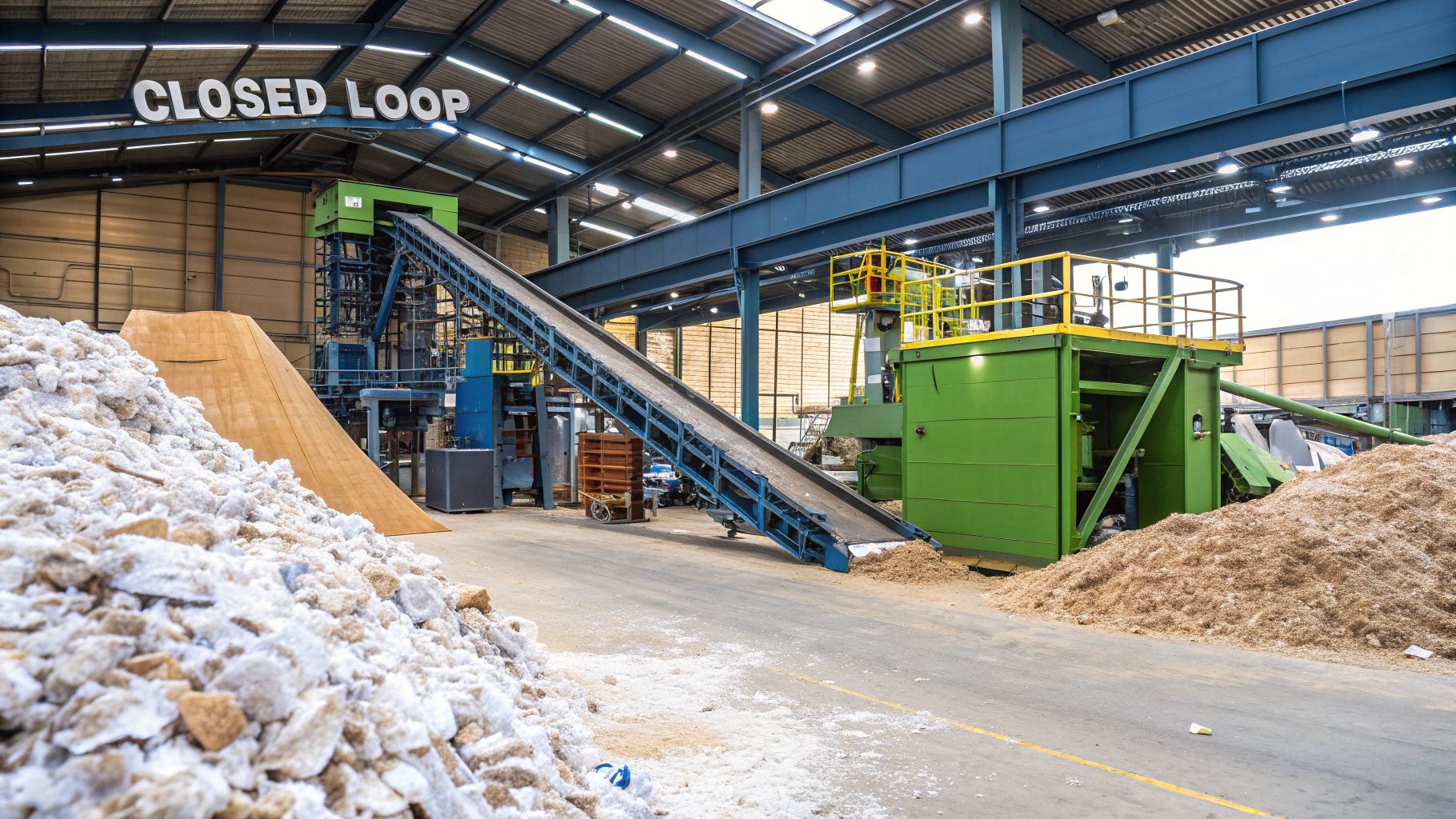
The first thing that happens is a thorough inspection. Plant operators will check the load to make sure it's free from the contaminants we've talked about. Once it gets the all-clear, the plasterboard is fed into powerful shredders. These machines make short work of the boards, breaking them into manageable chunks and giving the process a head start by separating the gypsum core from its paper lining.
The Separation and Purification Process
With the material now broken down, a series of advanced mechanical and air-based systems get to work. It’s a sophisticated sorting process with one simple goal: isolate the gypsum.
- Paper Extraction: Powerful air classifiers blow away the lighter paper fragments, which are collected in a separate stream. This recovered paper isn't wasted, either—it’s often sent on for recycling into other paper-based products or even used as animal bedding.
- Gypsum Purification: The heavier gypsum pieces carry on through the system. They’re screened and filtered to strip out any remaining fine impurities, leaving a clean, consistent gypsum powder.
This final product is known as rGypsum (recycled gypsum). The beauty of it is that, chemically, it's identical to newly mined gypsum. It's ready to go straight back into manufacturing without any drop in quality. The entire process is incredibly efficient, often recovering over 95% of the original gypsum from the plasterboard waste.
Closing the Loop From Old to New
This is where the transformation from waste to resource is complete. The purified rGypsum is transported to plasterboard manufacturers, mixed with water and additives to create a slurry, and then pressed between two new sheets of paper. The result? Brand new plasterboard. It's the perfect example of a closed-loop system.
By turning old boards directly into new ones, we drastically cut down on the need for virgin gypsum mining. That’s a big deal, because mining is an energy-hungry process with a serious environmental footprint. It’s a powerful way to conserve natural resources and lower carbon emissions in the construction industry.
Interestingly, the supply chain for recycled gypsum has had its ups and downs. UK plasterboard used to contain over 80% recycled material, but much of that was a by-product from coal power stations. As those have been phased out, the availability of that source has dwindled, making post-consumer waste from sites like yours even more critical.
As the industry adapts, our collective effort in recycling aggregates and other materials is absolutely vital. You can find more information about this transition from the Gypsum Products Development Association.
Common Plaster Recycling Mistakes to Avoid
Knowing how to recycle plaster is one thing, but sidestepping the common mistakes that can derail the entire process is a different ball game. I've seen it happen time and again: a well-intentioned recycling effort turns into an expensive trip to landfill because of a few simple, avoidable errors.
Learning from others’ experiences is the fastest way to get it right, saving you the frustration and unexpected costs of a rejected load.
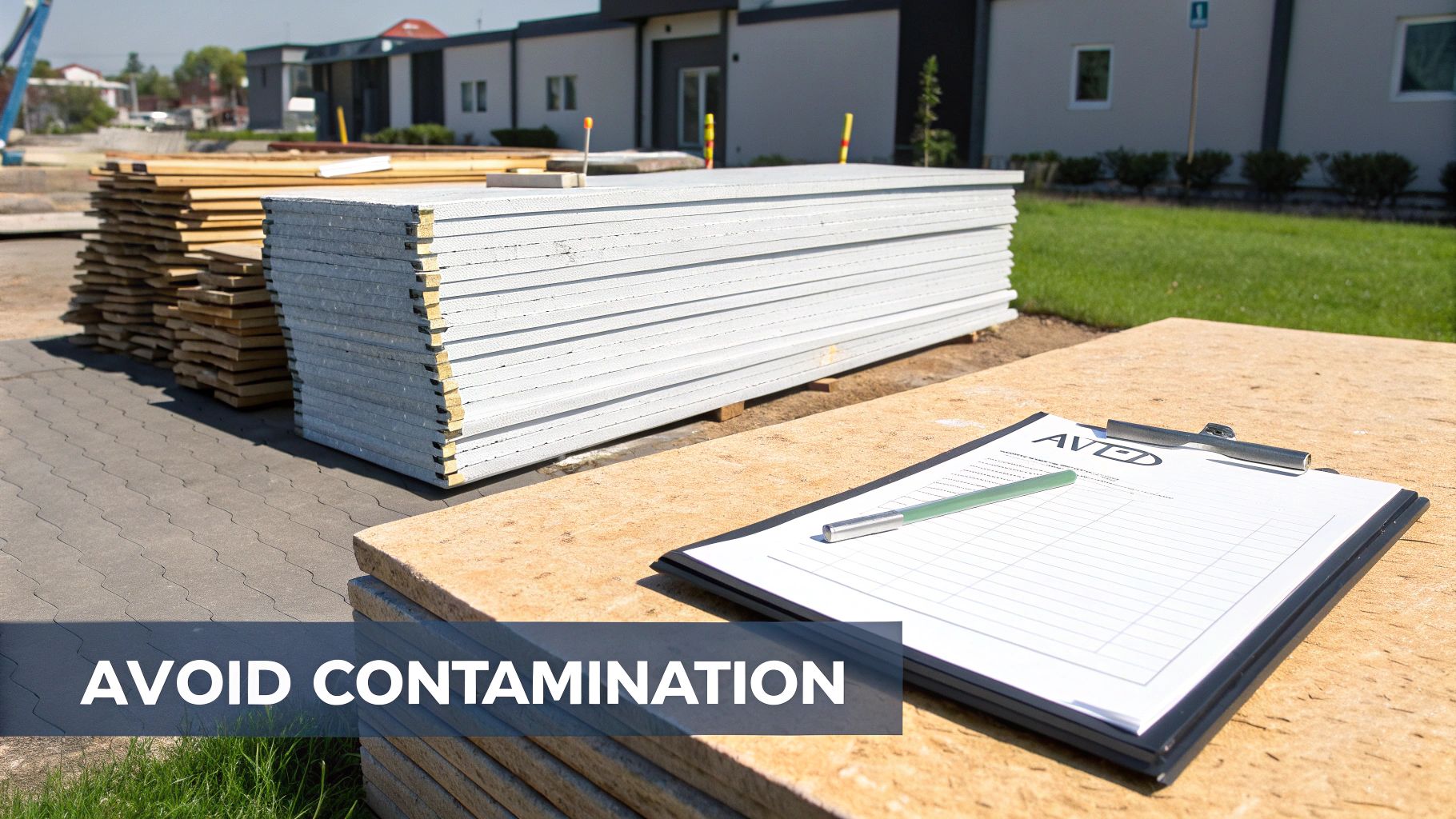
Many renovators, both DIY and professional, fall into the same traps. The biggest one? Simply underestimating how vital 100% segregation is. It’s easy to think a few stray screws or a bit of timber won’t matter, but the machinery at recycling plants is incredibly sensitive.
Even minor contamination can lead to an entire skip being refused. When that happens, you’re left footing the bill to dispose of it as pricey mixed general waste.
Cross-Contamination with Other Waste
This is, without a doubt, the number one reason plaster loads get rejected. Plasterboard has to be kept in its own dedicated waste stream. Once it’s mixed with bricks, wood, or general rubbish, it becomes almost impossible to separate efficiently.
The solution is simple but requires discipline. Right from the start of your project, set up a ‘plaster-only’ zone. This could be a dedicated skip, a clearly labelled row of bulk bags, or a designated corner of the site. The key is making sure everyone on site knows that nothing else goes in.
Forgetting to Strip the Plasterboard Clean
Another rookie error is chucking plasterboard into the skip without stripping it of attachments. Recycling facilities just aren't equipped to handle boards that still have other materials clinging to them. It gums up the works and ruins the final recycled gypsum product.
Before it goes in the pile, you must manually remove:
- Ceramic Tiles: A major contaminant. They have to be chipped off completely.
- Metal Fixings: That means pulling out every last screw, nail, and metal corner bead.
- Insulation: Any foam or fibre insulation bonded to the back needs to be stripped away.
- Wooden Frames: Bits of lath or timber battens are a no-go.
The rule of thumb is simple: if it isn't gypsum or the paper liner, it doesn't belong. Taking an extra 30 minutes to prep your plasterboard properly can save you hundreds of pounds in rejected load fees and landfill tax. It’s a small investment of time for a massive financial and environmental return.
Underestimating the Volume of Waste
It’s always surprising how quickly plasterboard waste adds up. A common mistake, particularly on DIY jobs, is not anticipating the sheer volume of material you’ll be dealing with. A small bedroom renovation can easily generate enough waste to overfill several bulk bags.
Before you start swinging a hammer, try to calculate the total square meterage of plasterboard you’ll be taking out. This gives you a much better idea of the right disposal method, whether that’s hiring a small skip or arranging a dedicated bag collection service.
A bit of planning upfront prevents the headache of having a mountain of plaster waste with nowhere to put it. For a deeper dive, understanding how to correctly dispose of plasterboard is essential for any project size.
To make it even clearer, I've put together a quick troubleshooting guide for the most frequent slip-ups.
Common Plaster Recycling Errors and Solutions
| Common Mistake | Consequence | How to Avoid It |
|---|---|---|
| Mixing with other waste | The entire load is rejected and reclassified as expensive mixed waste. | Establish a clearly marked, plaster-only container (skip or bag) from day one. Brief the entire team. |
| Leaving tiles or fixings on | Contaminates the gypsum, making it unsuitable for recycling. Leads to rejection. | Manually strip all boards of tiles, screws, insulation, and wood before placing them in the waste container. |
| Not ordering a big enough skip | Waste piles up on-site, creating hazards and requiring a last-minute, costly second collection. | Calculate the square meterage of plasterboard being removed beforehand to estimate the volume accurately. |
| Letting it get wet | Wet plasterboard is heavy, difficult to handle, and can be rejected by some facilities. | Keep your plasterboard waste covered with a tarpaulin, especially if it's being stored outside for any length of time. |
Avoiding these common pitfalls is the key to ensuring your efforts contribute directly to the circular economy, turning old building materials back into valuable new products.
Your Plaster Recycling Questions Answered
Let's clear up a few of the common questions we hear all the time about recycling plaster. Getting these details right is what separates a smooth, compliant disposal process from a costly headache.
Can I Put Small Amounts of Plasterboard in My Household Bin or a Council Skip?
That’s a hard no. It’s actually illegal to put plaster or plasterboard into your general household wheelie bin or any mixed waste skip you might see on the street.
In the UK, there are strict rules banning gypsum-based materials from being mixed with biodegradable waste in landfills. When gypsum breaks down with your regular rubbish, it can release toxic hydrogen sulphide gas. To keep things safe and legal, you must always use a dedicated collection service or a specific plasterboard-only skip.
What About Old Lath and Plaster Walls?
This one trips a lot of people up. Traditional lath and plaster walls, common in older properties, are a completely different beast from modern plasterboard. Unfortunately, they are almost impossible to recycle.
The old-school plaster mixes often contain things like horsehair, and trying to separate that from hundreds of tiny wooden laths just isn't practical on a commercial scale. Because of this, lath and plaster waste is usually classed as general mixed waste and has to be disposed of as such. The advice in this guide is all about modern, gypsum-based plasterboard.
Key Takeaway: Always know what you're dealing with. Modern gypsum plasterboard is easy to recycle, but old-fashioned lath and plaster is not. Identifying the material first is the most important step.
Is It Expensive to Hire a Dedicated Plasterboard Skip?
It’s often cheaper than you'd think, especially on bigger jobs. While the hire fee for a dedicated plasterboard skip might look similar to a mixed one, the big savings come from dodging landfill taxes.
Disposing of mixed waste that contains gypsum gets hit with hefty tax rates, which can really push up the final bill. When you segregate your plasterboard, you avoid those charges altogether. For any decent-sized renovation, the cost difference can be huge. It’s always worth getting a few quotes from local waste management firms to see for yourself.
Do I Need to Remove Paint or Wallpaper?
For the most part, no. You don’t need to spend hours scraping off every last bit of paint or wallpaper. The industrial recycling process is powerful enough to handle these surface layers, easily separating the paper and paint from the gypsum core inside.
But there are exceptions. You must remove anything chunky that's stuck to the board's surface. Think things like:
- Thick vinyl wallpapers or coverings
- Ceramic tiles and the adhesive used to fix them
- Any kind of heavily textured or multi-layered wall coverings that aren't just simple paper
Planning your next renovation project? Don't let waste management become an afterthought. At The Waste Group, we make responsible plaster recycling simple with dedicated skips and collection services across Dorset. Get a competitive quote online and know you're handling your waste the right way. Find your perfect waste solution at https://www.thewastegroup.co.uk.
